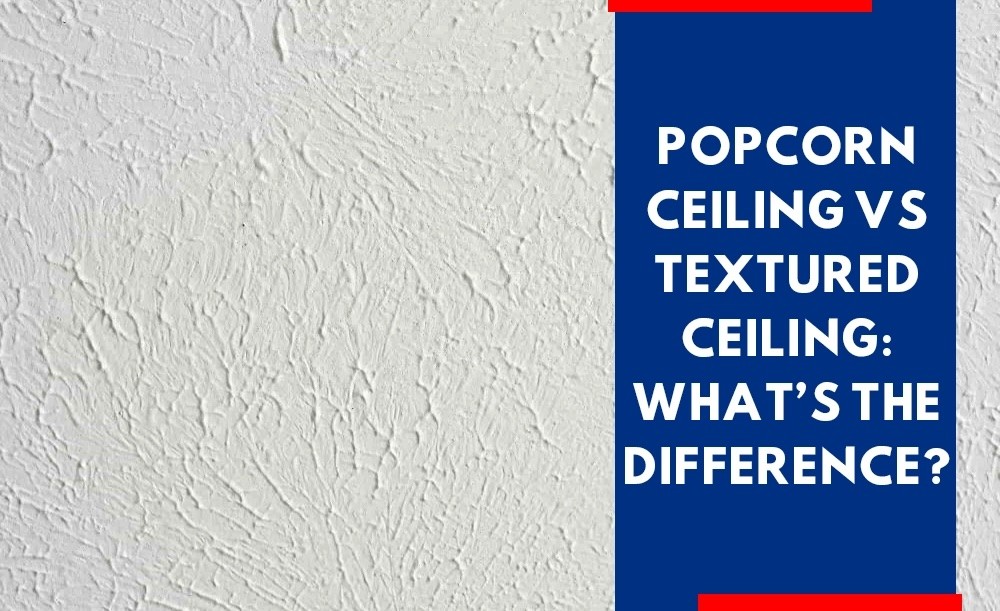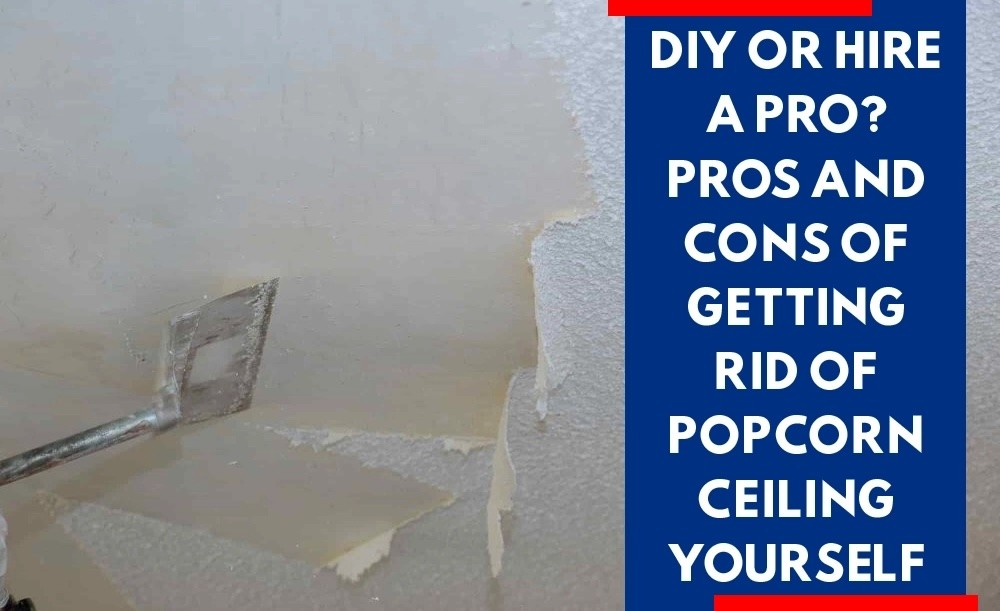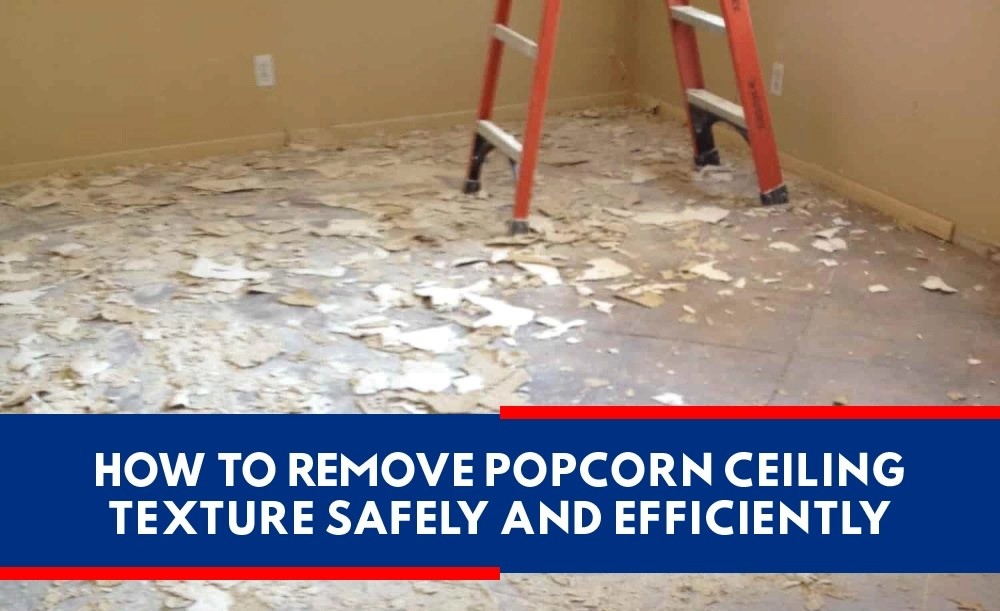DIY or Hire a Pro? Pros and Cons of Getting Rid of Popcorn Ceiling Yourself
Popcorn Ceiling vs Textured Ceiling: What's the Difference?

Table of Contents
If you’re looking to renovate your home, chances are that you’ve been faced with the decision of which ceiling design is best for your space. Popcorn ceilings and textured ceilings have long been popular options for homeowners – but what exactly makes them different? In this article, we will discuss popcorn ceiling vs textured ceiling: what’s the difference?
While similar in appearance, there are some important distinctions when it comes to popcorn vs textured ceilings. To begin, popcorn ceilings are made from a spray-on material consisting of paint mixed with an acoustic material like Styrofoam beads or vermiculite. This type of ceiling was widely used in homes built before 1980 due to its soundproofing capabilities and low cost. On the other hand, textured ceilings are created by applying heavy-duty drywall joint compound directly onto the ceiling surface using a variety of tools such as trowels and brushes. Textures vary based on the technique used; common textures include orange peel, knockdown, swirls, combed lines, and stippling.
When it comes to maintaining ceiling surfaces, there are key differences between popcorn and textured options. Not only are their construction methods distinct, but their maintenance needs also vary. Popcorn ceilings tend to be more resilient, but they may require occasional re-spraying if they become discolored. On the other hand, textured ceilings can be challenging to clean due to their complex patterns, often requiring the expertise of commercial painters in Plano, TX to remove dirt and dust effectively. Ultimately, the decision to go with a popcorn or textured ceiling comes down to personal taste, budget, and long-term upkeep considerations.
A popcorn ceiling, also known as a “cottage cheese ceiling” or an acoustic ceiling, is made up of a textured joint compound that has been sprayed onto the surface. This texture gives it its signature bumpy and pitted look. The process involves applying wet joint compound to a drywall surface using either a hopper gun or trowel technique. Once applied, the joint compound will harden into small bumps which create a unique patterned effect on the ceilings. It's important to note that this type of texture should be installed by professionals for the best results.
Popcorn textures are most commonly used in residential buildings built before 1980 due to their ability to hide imperfections in the drywall such as nail pops and seams from installation. Even today, some homeowners still choose popcorn ceilings because they can help reduce sound reverberation within the home and provide noise insulation between floors of multi-level homes. Additionally, these textures can offer quick coverage over existing surfaces with minimal effort making them cost-effective options for renovation projects with tight budgets.
Ceiling textures can add a unique character to a room and provide sound insulation and noise reduction. Popcorn ceiling texture was a popular choice in homes built before 1980 due to its ability to conceal imperfections and provide these benefits at a low cost. However, for those who want a more contemporary look, smooth ceilings or stipple ceilings might be a better choice. Stipple ceilings are created by applying joint compound to drywall using a brush or trowel technique, resulting in slightly larger bumps than popcorn textures. In addition to being easier to clean, this texture provides a modern feel to any space.
A skim coat is another popular option for those who prefer an ultra-smooth finish on their ceilings. This method involves covering the entire ceiling with multiple thin layers of joint compound until you achieve your desired level of coverage and smoothness. While this procedure does take longer to complete than installing popcorn or stipple textures, many homeowners choose to skim coating because it offers better protection against water damage over time due to its dense nature.
Whether you decide on popcorn textures, stipple ceilings, or skim coating - no matter what style you ultimately choose make sure that you consult professionals beforehand so that your project goes off without a hitch!
Although popcorn ceilings have many benefits, there are some potential drawbacks to consider before installing one. The drywall compound used in the application of a popcorn ceiling contains asbestos fibers which can become airborne if disturbed or damaged. Asbestos is a known health hazard and prolonged exposure has been linked to serious respiratory diseases such as mesothelioma and lung cancer. Additionally, even after installation, homeowners need to take precautions when cleaning their popcorn ceilings as doing so could release harmful particles into the air.
Furthermore, those with allergies may experience an increase in symptoms due to the dust particles that get trapped in these textured surfaces over time. In severe cases, this accumulated dust has even been known to trigger asthma attacks in certain individuals who are particularly sensitive. Fortunately, though, newer versions of popcorn textures use safer materials that don't contain any asbestos fibers - however, you'll still want to be sure to check with your local building authority first before making any decisions about what type of texture you should use on your ceiling.
Textured ceilings are a great alternative to popcorn ceilings, offering an array of unique benefits that set them apart from the traditional option. For starters, they’re much easier on the eyes than popcorn textures and can instantly transform a room with minimal effort. The smooth ceiling texture is also more modern-looking and can make a space look bigger by creating an illusion of extra square footage in the area.
Not only do textured ceilings look nicer, but they’re also often safer for your health since there isn’t any asbestos involved as you would find with most popcorn styles. Additionally, depending on the type of texture you choose, it may be possible to hide imperfections or other blemishes that might otherwise stand out if using one of the flat ceiling options instead. This makes textured surfaces perfect for covering up small cracks or holes without having to replace large sections of drywall - saving time and money in the process!
In addition to the aesthetic and health benefits, textured ceilings also provide an array of practical advantages. For one thing, they're much easier to install than drywall or knock-down ceiling styles. Instead of having to painstakingly apply compound in small sections, you can simply roll on a special paint with texture mixed into it that will cover your entire wall surface quickly and efficiently. This makes them ideal for DIYers who don't want to spend a lot of time installing their new ceiling material!
What's more, textured popcorn ceilings are perfect for creating interesting visual effects in any space. Whether you're looking for something subtle like wood chip paper or bolder designs such as swirls and circles - these surfaces offer endless possibilities when it comes to customizing the look of your room without breaking the bank. And if you ever decide to redecorate later on down the road, all you'd have to do is repaint over the existing finish which takes hardly any effort at all!
Textured ceilings are becoming more and more popular for all the right reasons. Handling imperfections on walls, making rooms appear larger, and creating visually-striking designs - these types of surfaces have a lot to offer, and it's no surprise that it continues to be such a favorite among homeowners. To ensure your project is done correctly, consider **hiring a professional contractor in Plano, TX ** for the best results!
The major disadvantage of textured ceilings is that they can be difficult to repair. Unlike drywall mud which can easily cover up small cracks and holes, fixing any imperfections on a textured surface requires much more work. It's often necessary to sand down the area before applying compound and even then it may be hard to match the bumpy texture with the rest of the wall. As such, many homeowners opt for simply replacing their ceilings altogether if there are any significant damages as opposed to trying to fix them.
Another thing worth considering when choosing between popcorn or textured ceilings is a style preference. While both types of materials offer unique looks, popcorn-style surfaces tend to be the most popular choice among home decorators due to their classic look and ability to hide blemishes in walls. Textured finishes, however, provide a bit more visual diversity but might not fit everyone’s taste - so it’s important to take some time deciding which one will best suit your space before committing!
In conclusion, popcorn ceilings and textured ceilings are two popular ceiling options for homeowners in Plano, TX. Popcorn ceilings have a classic look but may contain asbestos, making them difficult to remove without professional help. Textured ceilings can provide an interesting aesthetic with less risk of health hazards since they often don’t include asbestos. It’s important to consider the differences between these two types of ceilings before choosing one for your home.
An interesting statistic is that according to the National Association of Home Builders (NAHB), over 70% of new homes built in 2019 included some kind of textured surface on the walls or ceiling. With this information in mind, it's clear that many people prefer adding texture to their interior spaces instead of opting for a traditional flat finish like a popcorn ceiling might offer.
Ultimately, when deciding between popcorn and textured ceilings, you should weigh the pros and cons carefully based on your needs and preferences. Whether you go with a classic popcorn style or something more modern like a textured option, make sure to research any potential health risks associated with either choice beforehand so you can be confident about your decision.
Author

Mason Marquis, raised in Newport Beach, California, and Austin, Texas, amalgamated his experiences from both vibrant cities in his journey. His academic pursuit in Economics and Psychology at the University of North Texas (UNT) led to the founding of Spray Tex Painting. This venture was not just a business for Mason but a practical application of his academic learnings, particularly the integration of economic concepts and psychological understanding. Spray Tex Painting, under Mason's direction, transcends being merely a painting service; it's a platform where client visions are realized through dedication and creativity.
Related Articles

DIY or Hire a Pro? Pros and Cons of Getting Rid of Popcorn Ceiling Yourself

Evolution of Popcorn Texture on Ceilings: A Brief History and Future Trends

Health Hazards of Popcorn Ceiling Texture: Why You Should Consider Removal

How to Remove Popcorn Ceiling Texture Safely and Efficiently